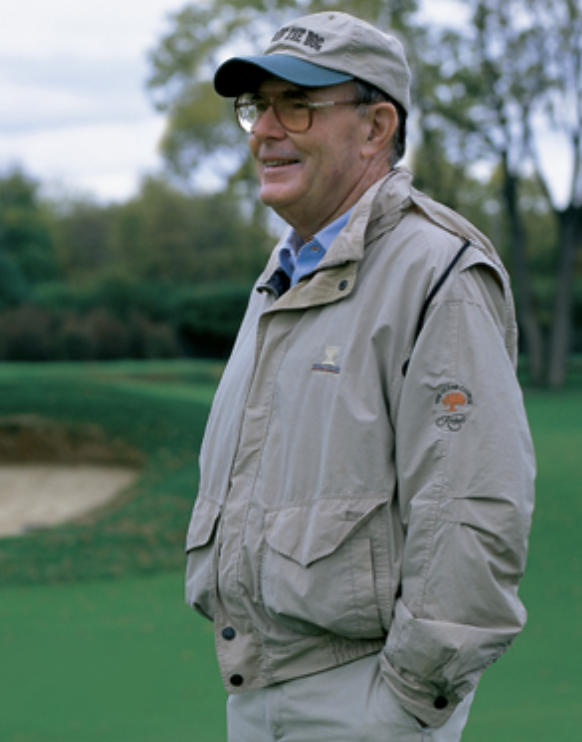Pete Dye
American
1925 - 2020

American
1925 - 2020

In the world of golf course architecture, few names resonate as profoundly as that of Pete Dye. Born in Urbana, Ohio, in 1925, Dye would grow to redefine modern golf course design, blending artistry with a keen understanding of the sport. His journey from amateur golfer to the architect of some of the most challenging and admired courses in the world is a testament to his innovation, creativity, and the indelible mark he left on the game of golf.
Pete Dye’s early exposure to golf came from his father, “Pink” Dye, who was an avid golfer and course designer in his own right. Pete’s initial foray into the sport was marked by his success as an amateur golfer which landed him in the ideal location in the Army. Dye entered the Airborne School at Fort Benning during WWII, but the war ended while he was in training to be a paratrooper. He was then stationed at Fort Bragg in North Carolina where he served the rest of his hitch as greenskeeper on the base golf course and not far from Pinehurst.
“I played the golf course at Pinehurst No. 2 for six solid months, and I got to know Mr. Donald Ross who had built the Fort Bragg golf course. He would come over and watch us play golf, and most of the time the captain and colonel hauled me over there. They didn’t know who Mr. Ross was, but the other fellow walking with him was JC Penney, and they all knew him.”
After the army and studying at Rollins College in Florida, Dye embarked on a career in insurance. While he was always a salesman and successful at selling insurance, his passion for golf soon led him to pursue golf course design full-time, a decision that would forever change the landscape of golf.
“The ardent golfer would play Mount Everest if somebody put a flagstick on top,” – Pete Dye
In the late 1950s, Pete and his wife, Alice Dye, also a skilled golfer and eventual collaborator, embarked on a trip to Scotland. This journey proved pivotal, as Dye was inspired by the links courses of the British Isles which would influence his approach to design. Known for ingenuity and challenge, Dye-designed courses including TPC Sawgrass, Whistling Straits, and Harbour Town Golf Links, are celebrated for their distinctive features: well-contoured greens, pot bunkers, railroad ties, and imaginative use of water hazards. Pete Dye courses emphasize his design philosophy to the point you can tell when you’re standing on the tee of one of his designs.
Dye’s courses are also characterized by a strategic demand on players, requiring thoughtful navigation and precision. He famously said, “I never wanted to be fair; I wanted it to be fun.” This approach has been described as “visual intimidation” and it has both frustrated and fascinated golfers, making Dye courses a unique challenge that calls to golfers’ skill, strategy, and spirit.
What doesn’t get as much credit in Dye’s work is the impact of his wife, Alice Dye, a talented golfer and course architect in her own right. Alice was not only a collaborator but also a profound influence on Pete’s designs. She was a champion of forward tees, advocating for courses that were accessible and enjoyable for golfers of all skill levels, a principle that would come to be known as “Alice’s Law.” Her input was instrumental in the creation of some of the most iconic holes in golf, including the infamous 17th hole at TPC Sawgrass. Alice’s perspective brought a balance to Pete’s designs, ensuring they were challenging yet fair, and her legacy in golf course design is inseparable from that of her husband.
The Dyes’ collaboration extended beyond their designs. Together, they were a formidable team in promoting golf and its values. They mentored young architects and were pivotal in the establishment of the American Society of Golf Course Architects. Their influence can be seen in the work of many contemporary designers, who continue to draw inspiration from the Dyes’ innovative approaches to golf course architecture.
The legacy of Pete Dye extends far beyond the fairways and greens of his courses. His visionary approach to golf course design has influenced generations of architects and players alike. Dye passed away in 2020, but his impact on the game is everlasting. Golf courses designed by Pete Dye are not just landscapes, they are landmarks in the history of golf, each telling a story of innovation, challenge, and the enduring love of the game. His work reminds us that golf is not just a sport but an art form, one that challenges us, delights us, and brings us closer to the beauty of the natural world.
Thanks to a lifetime of contributions to golf, Dye is in the World Golf Hall of Fame and earned a PGA Tour Lifetime Achievement Award, and Old Tom Morris Award, plus the ASCGA Donald Ross Award.
If you’re a fan of Pete Dye and his legendary golf courses, you’ll enjoy his autobiography, “
Pete Dye is best known for PGA tournament venues like TPC Sawgrass, Harbour Town, Kiawah Island, PGA West, and Whistling Straits. With his distinctive style of deep bunkers, island greens, and railroad ties, he combined the penal and heroic schools of design and defined a generation of golf course architecture in the 70s and 80s.